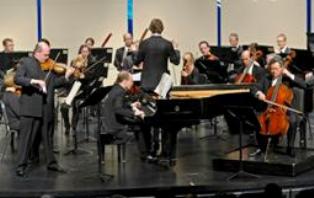
Old Friends at Cincinnati Chamber Orchestra

(first published in The Cincinnati Enquirer October 27, 2010)
The Cincinnati Chamber Orchestra’s “Ludwig Van!” arrived Sunday afternoon in Corbett Theater at the School for Creative and Performing Arts, just in time to open the CCO’s 39th season.
A partner event of the 2012 Constella Festival, it brought music by Ludwig van Beethoven, specifically his Concerto for Violin, Cello and Piano (Triple Concerto) and Symphony No. 4. In keeping with the theme of the CCO’s 2012-2013 season, “About the Town,” it brought guest artists with Cincinnati connections. Violinist Alexander Kerr was concertmaster of the Cincinnati Symphony Orchestra from 1995-1997. Cellist Eric Kim was CSO principal cellist from 1989-2009. Both now serve on the faculty of the Jacobs School of Music at Indiana University. Pianist Orion Weiss, who joined Kerr and Kim in the Triple Concerto, made his Cincinnati debut with the CCO in 2002 at the age of 20.
Doing the honors on the podium was CCO music director Mischa Santora, who brought some of his own history to the program, having conducted Beethoven’s Fourth Symphony on his first concert as a CCO music director candidate in February, 2000 (he was named to the post soon after).
It was sunny music for a cool and blustery day, beginning with the Triple Concerto. Kim led off after the orchestral introduction, setting a pure, classic tone for the work. Balances were excellent and Corbett Theater proved acoustically welcoming (the CCO made it their performance home last season after leaving Memorial Hall). The soloists displayed keen ensemble unity, both with each other and the CCO. (The work is more a piano trio with orchestral accompaniment than an actual give-and-take concerto with orchestra.)
Kim opened the second movement (Largo) with exquisite shaping and led into the Rondo alla polacca finale (“In Polish style”), as well. He spent considerable time in the cello’s highest register in close pitch proximity to the violin, clearly demonstrating Beethoven’s focus on the cello in this work (which he wrote for a fine cellist of his day). Kerr and Weiss had star turns, too, now and then, and all joined in the fireworks of the finale. Beethoven’s hi-jinks at the end (is it the end or not?) were handled with great good humor, sparking an enthusiastic response from the crowd.
The trio encored with a lovely reading of the slow movement of Mendelssohn’s Piano Trio in D Minor, Op. 49.
In remarks to the audience, Santora recalled his CCO debut in Beethoven’s Fourth Symphony. No doubt there were listeners in the crowd who did, too (including this writer), and Santora’s continuing affection for the work was apparent. The opening Allegro vivace was bright and vigorous, with a fine balance between strings and winds. (Clarinetist Miriam Culley was a standout throughout.) There was a good corporate blend among the strings, despite an occasional loose end. Santora conveyed the gentle nostalgia of the second movement (Adagio) and the humor of the third (Allegro vivace), with its hilarious cut-off of the horns in the final bars.
The closing Allegro, a jolly, bustling movement with some wonderful, in-your-face discords, had the CCO sounding larger than its numbers. Again, Santora reveled in its patent humor, bringing it to a teasing conclusion and with it, a thoroughly enjoyable concert.